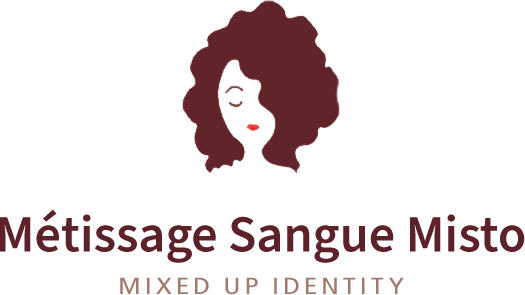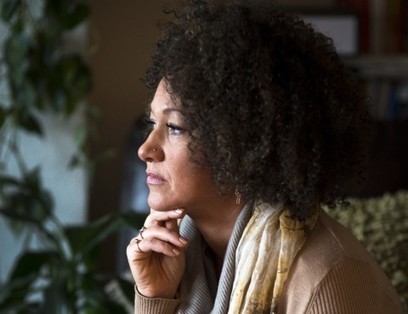Rachel Dolezal faced a backlash when it was revealed in 2015 that the NAACP and Black Lives Matter activist was not black, as she presented herself to be, but in fact white. (Colin Mulvany/Associated Press)
Back in 2015, I was fascinated by the scandal that swirled around Rachel Dolezal, the NAACP and Black Lives Matter activist who turned out to be a once-blonde white woman from Montana passing herself off as black. Dolezal went further than that: She said she wasn’t posing as black but actually was black — because she feels black. I made the rounds on the talk shows at the time, having published a book about the cultural history of such reverse racial passing, and avidly tried to explain notions of transraciality.
[Review: ‘Incarceration Nations: A Journey to Justice in Prisons Around the World,’ by Baz Dreisinger]
Now Dolezal has published a memoir, “In Full Color: Finding My Place in a Black and White World.” I hesitated to review it. Expending intellectual energy on one woman’s racial hoax seems a luxury of the pre-Trump era. And Dolezal’s increasingly bizarre story seems more tabloid fodder than a subject for serious analysis. But then I read her book, and the educator in me felt compelled to speak out. Dolezal has written an important book, one that belongs on syllabi as a case study in the mechanisms of white liberal racism. She has provided a teachable moment to expose the dodgy ideologies she may not even realize she’s espousing.
Her childhood reads like “Little House on the Prairie: The Nightmare Edition.” She writes that she was raised by Christian extremists who listed Jesus Christ as attendant on her birth certificate and called her gay uncle and his partner “the Sodomites”; extreme pro-lifers who believed that she and her brother, born after Roe v. Wade, were survivors of “a silent Holocaust.” She depicts her father as a vicious tyrant who beat her, made her eat her own vomit and “treated our home like his own private nudist colony.” She claims that she was subject to sexual abuse by her brother and that her four adopted siblings were locked in bedrooms and flogged with a baboon whip; one, she writes, was molested for years. Into adulthood, she says, she endured domestic violence, rape and poverty, and was a victim of hate crimes directed at her and her children.
[Rachel Dolezal struggles after racial identity scandal]
Dolezal’s parents and brother, as well as police department reports, dispute aspects of her account, so believing her story involves a leap of faith. Moreover, her story comes from a person who admits to being adept at “telling the truth without spelling out all the details,” who describes her depiction of her life as “creative nonfiction.”
She dramatically paints herself as a kind of tragic mulatto for the modern era. “Society has tried to strip me of my identity,” she writes, adding, “if my story can . . . provide some measure of comfort to those who find themselves drifting somewhere between Black and white, or with no category at all, I’ll consider the struggle I’ve endured simply for living as my true self to be entirely worth it.”
But I have trouble conjuring up sympathy in her case, since she is hardly the only one in the globalized, Obama-era world whose identity cuts across complex lines of culture and race. To that end, her ideas about racial identity are stunningly simplistic. “Yes, my parents weren’t Black, but that’s hardly the only way to define Blackness,” she writes. “The culture you gravitate toward and the worldview you adopt play equally large roles.” Culture matters: agreed. Yes, race is a social construct — but race also has very real implications. Yes, you can be born as one thing and identify as another; you can look one way and feel another. But it’s not an either-or equation — the complexity of identity involves intersectionality, sometimes from moment to moment. As the critic Eric Liu put it, racial identification is not simply a matter of embrace or efface; as Walt Whitman phrased it, we are many — we contain multitudes.
Dolezal diligently studied blackness. She read “Black history” books because she wanted to serve as a “cultural translator” for her adopted black siblings, “helping them navigate the white world safely while trying to keep them connected to the Black one.” The library was her refuge because, with the exception of a neighbor, until college she didn’t know any black people, such that the notion of going to the Million Man March to see them in the flesh thrilled her. She never reflects, however, on the disconnect of wanting “to help the Black community realize economic and social justice” without knowing any of the actual people she hoped to help.
Her definition of blackness — this thing she paradoxically felt innately but still had to study to embrace it — is so woefully vague as to be meaningless. She variously describes it as “acknowledging our common human ancestry with roots in Africa” and “fighting for freedom, equality, and justice for people of African heritage around the world.” Here is where her whiteness really begins to show. In her I hear echoes of today’s quintessence of whiteness: Trump compulsively referring to “the African Americans” and thereby, in one expression, reducing manifold, complex identities and experiences to one easy-to-generalize-about, monolithic entity.
Just as Trump cannot seem to utter “the African Americans” sans “inner city,” Dolezal’s conception of blackness is steeped in a fetishizing of struggle, pain and oppression. Opting into the struggle is yet another place where her whiteness acutely rears its head. The choice to take on a racial mantle at will is a mark of white privilege; so, too, is the choice to take it off when it suits. Ironically, then, in manifesting her blackness she most flagrantly manifests her whiteness. During her early racial transition, in college in Mississippi, she began to live a “double life”: staying in white dorms but going to a black church on weekends. She showed up at one Black Students Association meeting and ran for club historian; in no time flat she was on the front lines of racial culture, working to increase black recruitment on campus, schooling her black friend in dance and organizing a “racial reconciliation” conference. How white it is that her transition to blackness instantly involved authority and power. “Tired of seeing white people taking center stage all the time,” she writes of her budding work as a visual artist, “I wanted to use my art skills to offer a more equitable and compassionate treatment of black culture.” White person, do you not grasp the contradiction here? Do you not see the white privilege all over this sentence?
Finally, there’s her mutating physical appearance. In college, she writes, her look became “more Afrocentric” — she sported box braids and dashikis — as an aesthetic choice. Later on in life, as she began darkening her skin in tanning salons, she claimed it was for her adopted son’s sake, so she’d look more like his mother. Her reasoning grows more and more absurd until it reads as desperate. She checked Native American on forms because of a great-grandmother’s ancestry; she defends checking “Black” on a job application by arguing that all of us could feasibly check the same box, “thanks to scientific evidence that says modern humans evolved from Africa.”
Dolezal justifies claiming blackness by saying it was the only way she could be close to black people: “I noticed how much more relaxed and comfortable Black people who assumed I was Black were around me. The minute I corrected them, the comfort level we’d enjoyed just a moment before disappeared, so I stopped doing it and started letting them identify me however they wanted to.” But this utterly eliminates the possibility of authentic cross-racial alliances and friendships. Most of all, she exhibits a shocking inability to fathom why her actions might be bizarre or offensive. She dismisses black people who criticized her, insisting they were “dissing me and invalidating my Blackness, [so] they could underscore theirs.” And she insists that “my hair never discomfited Black people. Quite the opposite.”
This jaw-dropping myopia displays the book’s most acute dose of white privilege ideology, which essentially comes down to vision: blindness to the invisible knapsack of advantages one wears every day and, more than that, an all-around inability to properly see one’s privileged place in the world. Consider it the polar opposite of the double consciousness that W.E.B. Du Bois famously described, whereby African Americans must persistently, simultaneously see themselves while seeing others see them. To say Dolezal lacks such double consciousness is an understatement. She is most white in her dramatic inability to see why we cannot call her black.
By Rachel Dolezal with Storms Reback
BenBella. 280 pp. $24.95





